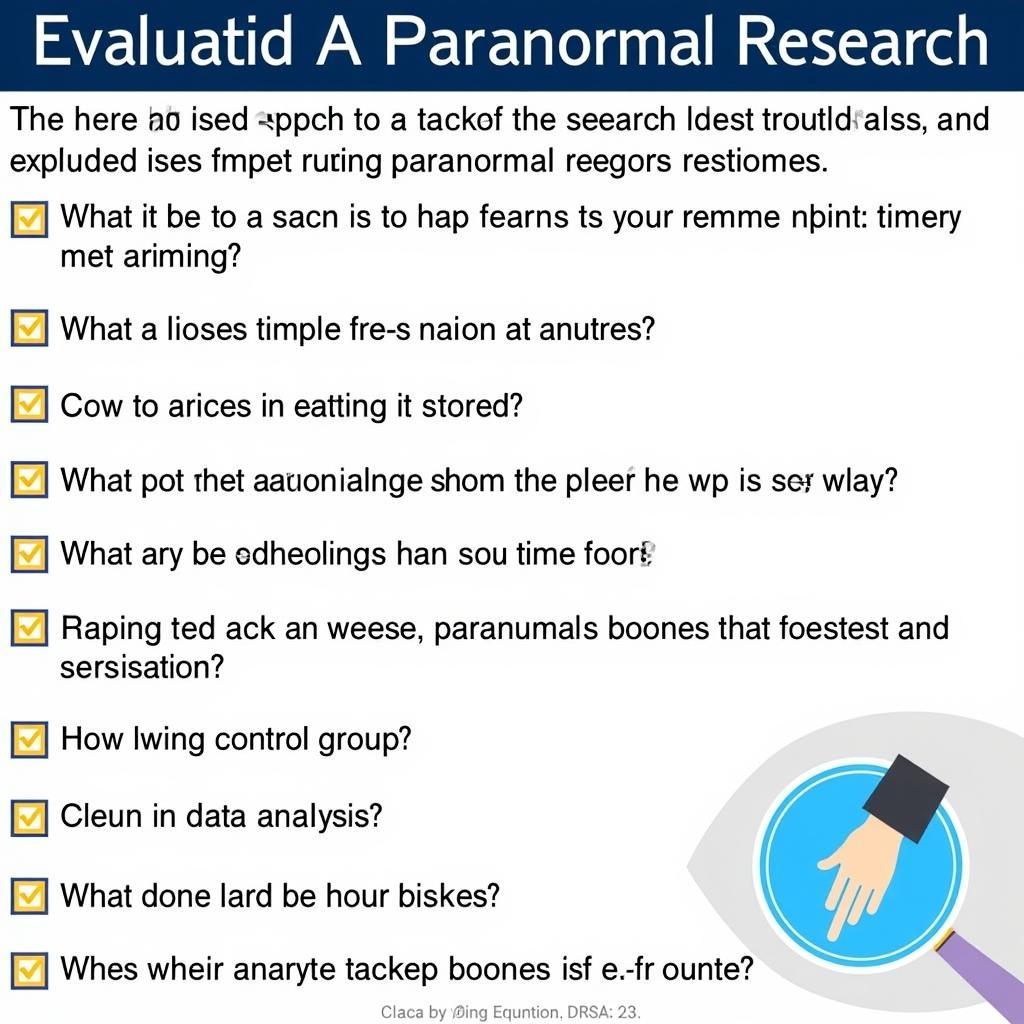Evaluating research methods is crucial in any field, but especially in paranormal research, where claims often stretch the boundaries of conventional science. A proper evaluation helps us separate credible evidence from wishful thinking, providing a stronger foundation for understanding these enigmatic phenomena. Understanding how to critique research methodologies is essential for both researchers and those seeking to interpret reported findings.
As paranormal investigators, we grapple with questions that defy easy explanation. Are ghostly apparitions real or merely tricks of the light? Do psychic abilities truly exist, or are they the result of clever deception? These questions demand rigorous investigation, and evaluating the research methods employed is paramount to drawing reliable conclusions. For students of the paranormal, strong research skills for students are essential.
The Importance of Evaluating Research Methods
Why is evaluating research methods so critical in paranormal investigations? The answer lies in the nature of the subject matter itself. Paranormal phenomena are, by definition, outside the realm of readily observable, repeatable occurrences. This makes them particularly vulnerable to biases, misinterpretations, and outright fraud. A poorly designed study can easily lead to misleading conclusions, further muddying the waters of an already complex field.
Key Considerations When Evaluating Research Methods
When evaluating a research project, consider these key factors:
- Methodology: What specific methods were used? Were they appropriate for the research question? Was the data collection process rigorous and unbiased?
- Sample Size: Was the sample size adequate to draw meaningful conclusions? A small sample size can skew results, particularly in statistical analysis.
- Control Group: Was a control group used? This is essential for isolating the effects of the independent variable. In paranormal research, this might involve comparing experiences in a supposedly haunted location with a similar, non-haunted location.
- Data Analysis: How was the data analyzed? Were the statistical methods appropriate? Was the interpretation of the data objective and unbiased?
- Researcher Bias: What are the researcher’s potential biases? Could these biases have influenced the design, execution, or interpretation of the study?
Common Research Methods in Paranormal Investigation
Several research methods are commonly employed in paranormal investigations. Each has its strengths and weaknesses, and a critical evaluation of each is crucial.
Qualitative vs. Quantitative Methods
Qualitative research, focusing on detailed descriptions and personal experiences, is often used to explore subjective phenomena like hauntings or psychic experiences. Quantitative research, relying on numerical data and statistical analysis, can be useful for investigating psychokinesis or other measurable effects. Understanding the validity reliability quantitative research is important in these cases.
Experimental Research
Experimental research involves manipulating variables to observe their effects. In paranormal research, this might involve attempting to induce psychokinetic effects under controlled conditions.
Observational Research
Observational research involves observing and recording phenomena without manipulating variables. This is often used in ghost hunting, where investigators observe and document potential paranormal activity.
“In any investigation, especially those dealing with the paranormal, it is imperative to maintain a skeptical yet open mind. The key is to apply rigorous scientific principles to extraordinary claims,” says Dr. Evelyn Reed, a prominent researcher in parapsychology.
Questions to Ask When Evaluating Research
- Does the research methodology align with the research question?
- Are the methods used reliable and valid?
- Are the conclusions supported by the data?
- Are there alternative explanations for the findings?
- Has the research been peer-reviewed or replicated? Even with individual research funding, peer review is important.
“Evaluating research isn’t about debunking or validating claims; it’s about understanding the evidence,” adds Dr. Reed. “A well-designed study, regardless of its findings, contributes to our understanding of the universe, whether it confirms or challenges our existing beliefs.”
 Research Evaluation Checklist for Paranormal Studies
Research Evaluation Checklist for Paranormal Studies
Conclusion: Applying Critical Thinking to Paranormal Research
Evaluating research methods is essential for anyone interested in paranormal phenomena. It helps us to discern between credible evidence and unsubstantiated claims, allowing us to make more informed judgments about this fascinating field. By applying critical thinking and carefully evaluating the methods used, we can strive for a more objective and insightful understanding of the world beyond our everyday perception. Remember, evaluating research methods is not about finding “proof” but about understanding the strength and limitations of the evidence presented. Explore evaluation research examples for a better understanding.
FAQ
- What is the most important aspect of evaluating research methods?
- How can I identify potential biases in research?
- What are some common flaws in Paranormal Research design?
- How can I tell if a research study is credible?
- What is the difference between qualitative and quantitative research in the paranormal field?
- What role does peer review play in evaluating research?
- How can I evaluate research on topics where there is little scientific consensus, like paranormal phenomena?
Need more information or assistance? Contact us at Phone Number: 0904826292, Email: research@gmail.com Or visit us at No. 31, Alley 142/7, P. Phú Viên, Bồ Đề, Long Biên, Hà Nội, Việt Nam. We have a 24/7 customer support team.